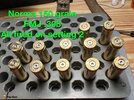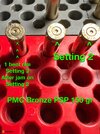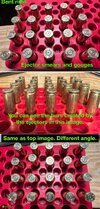Pat Riot
Contributing Member
I am kind of upset / disappointed. My SFAR let me down. Today is the first day of deer season here and my SFAR, the gun that was going to be my deer rifle is lounging at FedEx awaiting shipment to NC.
After a 200 round break in and a really good cleaning I took some ammo to the range last week for some final accuracy testing and I had installed a riser on my rail to raise my scope a bit more so re-sighting in was needed.
I fired some Norma .308 150gr FMJ to get the scope dialed in on the paper at 100 yards. The gas setting was on 2. I fired a dozen rounds getting it centered on a bullseye with no problems.
I then loaded up 3 rounds of PMC Bronze 150gr PSP (power soft point) hit a near bullseye but the gun didn’t feed the 2nd round so I reset everything and fired. Another near bullseye but the gun didn’t cycle properly so I adjusted the gas to 3. I fired and hit the bullseye. When I picked up the 3rd case the rim was bent. Too much gas.
I decided to go ahead and test my hand loads using Federal brass, IMR-4895 powder and Hornady 150gr SST Bullets. At this point I was shooting for groups. Once I got the tightest group I would dial it in on the bullseye at 100 yards.
I set the gas setting back to 2. I fired. A little low, but the gun cycled. The gun did not cycle the 2nd shot or the third. I decided to go to the other end of my ammo box for the test loads with the most powder to see if the #2 gas setting would work with them. I calculated these loads to be at around 2800fps. I do not have a chronograph.
Anyway, I got misfeeds so I set the gun on 3 and proceeded to shoot running a bore snake every few rounds. I fired 20 in total and was getting great patterns
I was collecting my brass when something sliced my knuckle open. Time for a bandaid. I looked at my brass and it had the weirdest galling on the head of the brass. My ejectors were tearing gouges in the brass.
I quit shooting and went home and verified that my loads were within safety margins - I never run max loads. They were within the safe range of the manuals.
I went online and started researching this and I found numerous discussions on forums regarding this very thing.
What’s the cure? Send it back to Ruger…and that’s where it’s going.
There were a few people that enlarged the gas aperture on the #2 setting of the gas adjustment plug to get things working the way they wanted, but I figure “Why should I have to improve a new gun?” So I called Ruger.
Here are some photos with notes.
Oh, remember I said the gun was patterning, not grouping? The damn riser I bought off Amazon loosened itself up after I installed it per instructions. 25 in/lbs of torque on the 3 screws. That thing’s going in the junk box. I am buying new scope rings at the proper height.



special note - if you have an SFAR clean that adjustable gas system every 100 rounds or so. 200 rounds is too long. It was a pain to get it apart to clean it.
After a 200 round break in and a really good cleaning I took some ammo to the range last week for some final accuracy testing and I had installed a riser on my rail to raise my scope a bit more so re-sighting in was needed.
I fired some Norma .308 150gr FMJ to get the scope dialed in on the paper at 100 yards. The gas setting was on 2. I fired a dozen rounds getting it centered on a bullseye with no problems.
I then loaded up 3 rounds of PMC Bronze 150gr PSP (power soft point) hit a near bullseye but the gun didn’t feed the 2nd round so I reset everything and fired. Another near bullseye but the gun didn’t cycle properly so I adjusted the gas to 3. I fired and hit the bullseye. When I picked up the 3rd case the rim was bent. Too much gas.
I decided to go ahead and test my hand loads using Federal brass, IMR-4895 powder and Hornady 150gr SST Bullets. At this point I was shooting for groups. Once I got the tightest group I would dial it in on the bullseye at 100 yards.
I set the gas setting back to 2. I fired. A little low, but the gun cycled. The gun did not cycle the 2nd shot or the third. I decided to go to the other end of my ammo box for the test loads with the most powder to see if the #2 gas setting would work with them. I calculated these loads to be at around 2800fps. I do not have a chronograph.
Anyway, I got misfeeds so I set the gun on 3 and proceeded to shoot running a bore snake every few rounds. I fired 20 in total and was getting great patterns
I was collecting my brass when something sliced my knuckle open. Time for a bandaid. I looked at my brass and it had the weirdest galling on the head of the brass. My ejectors were tearing gouges in the brass.
I quit shooting and went home and verified that my loads were within safety margins - I never run max loads. They were within the safe range of the manuals.
I went online and started researching this and I found numerous discussions on forums regarding this very thing.
What’s the cure? Send it back to Ruger…and that’s where it’s going.
There were a few people that enlarged the gas aperture on the #2 setting of the gas adjustment plug to get things working the way they wanted, but I figure “Why should I have to improve a new gun?” So I called Ruger.
Here are some photos with notes.
Oh, remember I said the gun was patterning, not grouping? The damn riser I bought off Amazon loosened itself up after I installed it per instructions. 25 in/lbs of torque on the 3 screws. That thing’s going in the junk box. I am buying new scope rings at the proper height.



special note - if you have an SFAR clean that adjustable gas system every 100 rounds or so. 200 rounds is too long. It was a pain to get it apart to clean it.


